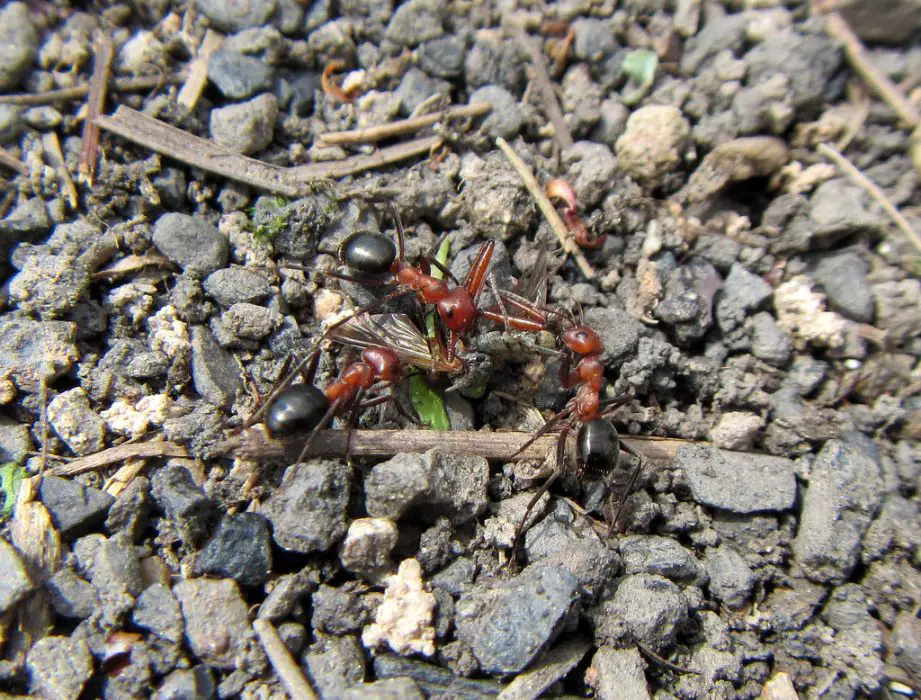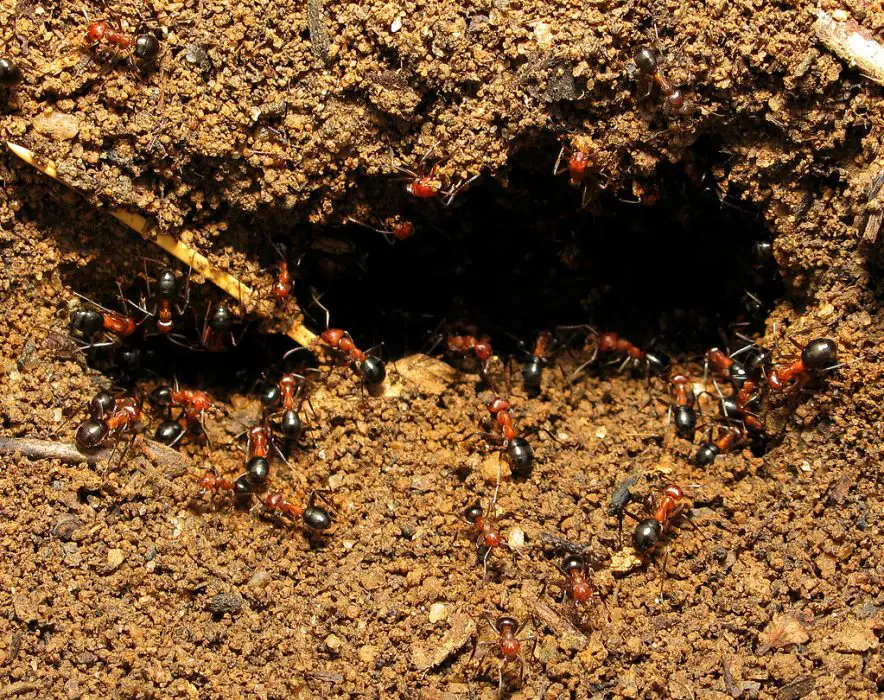Step into the hidden world beneath your feet, where an enchanting realm awaits exploration, mirroring the grandeur of the civilizations above. Allow me to introduce you to Formica exsectoides, known as the Allegheny Mound Ants.
These unassuming creatures may be diminutive in size, but they wield astonishing power, akin to the architects of earthen mounds. As we delve into their world, let’s uncover the secrets held by these tiny titans. Join us as we journey through their unique appearances, insatiable appetites, and captivating interactions with the world around them.
Curious about their temperament? Eager to discover their stinging defense? Stay with me as we embark on an exploration of the captivating realm of these remarkable creatures.
Prepare to immerse yourself in the enthralling narrative of the Allegheny Mound Ants, and as we transition further into their world, uncover a world that both astonishes and bewitches!
What do Allegheny Mound Ants look like?
Allegheny Mound Ants have distinctive physical characteristics that set them apart in the world of ants. These ants are typically reddish-brown to black in color.
Here’s a closer look at their appearance:
- Size: Allegheny Mound Ants are relatively large compared to some other ant species. Workers can measure around 4 to 6 millimeters in length.
- Color: Their bodies are usually dark brown to black, and they may have reddish-brown hues on their thorax and legs. This coloration helps them blend in with the soil and leaf litter in their natural habitat.
- Body Structure: They have a well-defined, slender waist (known as the petiole) that separates the thorax from the abdomen. Their bodies are covered in fine hairs, giving them a slightly fuzzy appearance.
- Mandibles: Allegheny Mound Ants have strong, curved mandibles (jaws) that they use for various tasks, including hunting and carrying food.
- Antennae: Like all ants, they have bent antennae, but the antennae of Allegheny Mound Ants are not as distinctive or elongated as those of some other ant species.
- Queens: The queens are usually larger and bulkier than the worker ants. They have wings during their reproductive stage, which they shed after mating.
What Do Allegheny Mound Ants Eat?
Allegheny Mound Ants, like many ant species, have diverse dietary preferences.
Their diet mainly consists of the following:
- Insects and Other Small Prey: These ants actively function as carnivorous predators, actively hunting for insects, arthropods, and other small creatures within their environment. Worker ants actively venture out from the colony, capturing prey that is subsequently brought back to the nest to feed the colony.
- Honeydew: In addition to hunting, these ants actively engage in mutualistic relationships with aphids and scale insects. They actively “milk” these insects for honeydew, a sugary secretion actively produced by the aphids and scale insects as they feed on plant sap. The ants actively protect and tend to these insects, receiving a steady supply of honeydew in return as a food source.
- Nectar: Allegheny Mound Ants actively forage for nectar from flowers, playing a vital role in pollination. As they actively collect nectar from various flowers, they actively benefit both themselves and the plants.
- Fruits and Plant Matter: These ants may also actively consume ripe fruits and occasionally scavenge for plant material.
- Protein Sources: They actively scavenge for protein-rich food items, such as dead insects or other organic matter.
Allegheny Mound Ant Nest

The nests of Allegheny Mound Ants comprise remarkable structures pivotal to their survival and social organization.
Here’s a concise overview of these nests:
- Mound Construction: Allegheny Mound Ants actively construct large earthen mounds, which can reach heights of over three feet. These mounds consist of soil, plant material, and the ants’ secretions, serving as both the colony’s fortress and its hub of activity.
- Subterranean Chambers: Beneath the surface, these ants meticulously craft an intricate network of tunnels and chambers. These chambers actively serve various functions, including housing the queen, brood (eggs, larvae, and pupae), and food storage.
- Ventilation System: The mound structure actively features a built-in ventilation system. Small holes and tunnels actively facilitate airflow, maintaining stable temperature and humidity levels within the nest.
- Entrances and Exits: Allegheny Mound Ants actively maintain multiple entrances and exits to their nests, often hidden amid the surrounding vegetation. These entrances actively disperse foraging ants and provide escape routes in case of threats.
- Social Organization: The nest layout actively reflects the complex social structure of the colony. Different castes of ants, such as workers, soldiers, and the queen, actively occupy specific chambers and perform distinct roles within the nest.
Do Allegheny Mound Ants Bite?
Do Allegheny Mound Ants wield a secret weapon? What unfolds when these unassuming ants decide to bite? In this exploration, we unravel the mysteries behind Allegheny Mound Ant bites, delving into the causes and the impact of these intriguing defenses.
Indeed, Allegheny Mound Ants are capable of biting, and their bites can induce pain, albeit they are not considered dangerous to humans. The primary cause of Allegheny Mound Ant bites is defensive behavior. When these ants perceive threats or encounter disturbances in their nest, they respond by biting as a means of defense.
Although their bites cause pain and discomfort, they typically do not pose a significant health risk to humans. Nevertheless, individuals with allergies or sensitivities to ant bites may experience more severe reactions.
How to Get Rid Of Allegheny Mound Ants?
Getting rid of Allegheny Mound Ants can pose a challenge, but persistence enables successful elimination.
Here’s how you actively manage and potentially eradicate these ants:
- Identify the Nest: Actively locate the primary mounds, which serve as central hubs. You may actively discover smaller satellite mounds nearby.
- Use Baits: Actively place ant baits near the mounds. Choose slow-acting baits that ants can actively carry back to the colony, allowing the bait to spread and affect the queen and other ants.
- Keep Clean: Actively eliminate food sources that attract ants. Seal food containers, actively clean up spills, and actively maintain a tidy environment.
- Seal Entry Points: Ants can actively enter your home through cracks and gaps. Actively seal these entry points to prevent their access.
- Natural Remedies: Consider using natural repellents like diatomaceous earth or a mixture of vinegar and water to actively deter ants from entering your home.
- Professional Help: If the infestation persists or is extensive, actively consult a pest control professional. They can assess the situation and actively implement appropriate treatments.
- Repeat as Needed: Ant colonies may take time to fully eliminate. Actively continue baiting and monitoring the situation until the ants are gone.
Conclusion
In conclusion, Allegheny Mound Ants, with their intriguing appearances, dietary habits, and complex nest structures, actively demonstrate a captivating world beneath our feet. While their bites are generally not dangerous to humans, their defensive mechanisms actively underscore their remarkable adaptations.
Managing infestations requires persistence and a strategic approach. Consequently, these tiny titans offer a compelling glimpse into the astonishing complexities of nature, actively underscoring the wonders that exist even in the smallest of creatures.



